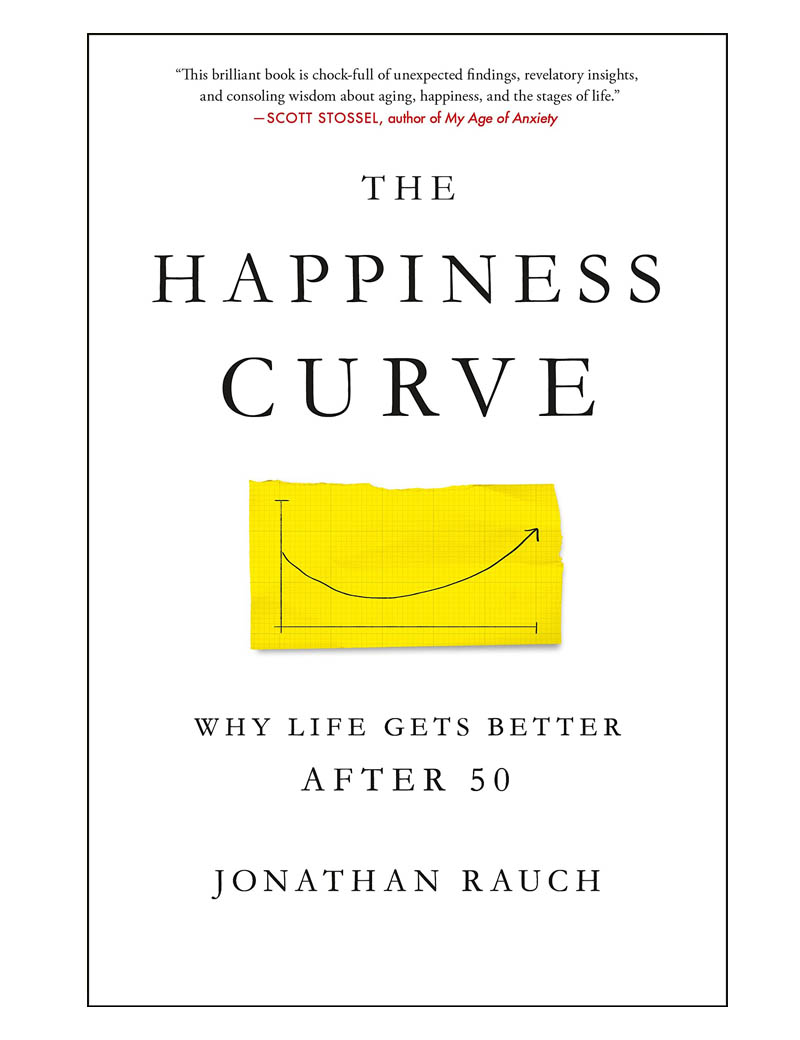Reviewed by Susan G. Abbott, susan@abbottresearch.com
ARC Strategy Ltd, Toronto, Canada
If you’re having a slump in your overall contentment with life with no obvious reason why, because you are otherwise happy in your relationships, have a successful career, and are in good health, you might just be at the wrong age! Jonathan Rauch is the author of The Happiness Curve: Why Life Gets Better After 50 and a journalist and senior fellow of the Brookings Institution, and when he had a midlife slump, he was in the right place to explore this idea.
In this very readable book, Rauch pulls together a wide variety of well-grounded academic research on human happiness, anchored with the individual stories of people he personally interviewed. The stories are used to bring the science to life.
When talking about happiness, an important distinction must be made between “affective happiness”, related to our short-term emotional state, and the happiness of life satisfaction, called “evaluative happiness” or “subjective well-being”. Rauch is not talking about moods, he is talking about overall contentment.
Large datasets now exist on human well-being, providing fruitful terrain for wide-ranging research in the social sciences. The World Happiness Report, referenced by Rauch and freely downloadable online, discusses many factors that influence human happiness in aggregate from a public policy perspective. He also reports on conversations on this topic with a number of the world’s leading researchers.
The core information in the book is that there is a happiness curve that is strikingly similar across all human societies. We start relatively happy as young adults at 18, and our overall happiness tends to decline to a minimum between age 40 and 50. After age 50, the curve marches steadily upward through the remainder of life.
While some countries are happier than others, evidenced by higher or lower curves, the pattern is consistent in that age itself has a powerful effect independent of other factors. The happiness curve shows us “how satisfied people would be if they were the same in all measurable respects, except for age.” It is possible to be happy in midlife, Rauch says, “but it is harder.”
Expectations of future happiness have also been studied. We tend to be overly optimistic below age 50, and overly pessimistic afterward. There is a significant gap between actual experienced life satisfaction and expected life satisfaction until the decade of the 50s, after which the reverse is true and we are then happier than we expected to be. The result is that we spend several decades experiencing disappointment and regret. Researchers hypothesize that the reason midlife is so difficult is that we are feeling disappointed about the past and pessimistic about the future, both at the same time.
Our experience of stress also varies strongly with age, presenting an approximately inverse curve to the happiness curve that is a hill rather than a U. In research with 1.5 million Americans, between ages 18 and 50, more than half experienced stress the previous day. From age 50 to 70, only 20% experienced stress the prior day.
The book debunks the concept of a midlife crisis, first postulated by organizational theorist Elliott Jaques in 1965. It is not a crisis so much as an evolution. The happiness curves are smooth in aggregate. Individual happiness curves are not smooth, of course—many experience big swings in life satisfaction from external circumstances such as marriage breakdown or illness. But the underlying trend that Rauch describes as a current in our lives is still at work.
Researchers will find this book provides important information about how human beings are wired. There are obvious ramifications for anyone marketing to those over 50, over 60, and older in that they are not as unhappy as youthful marketers may think. There are also ramifications for anyone working in the human resources field, whether in recruitment marketing or employee satisfaction. Social well-being is a topic of increasing concern in public policy, as human happiness indices take their place beside economic indices. And if you happen to be in your 40s, this book will give you hope that things will get better.


Be the first to comment